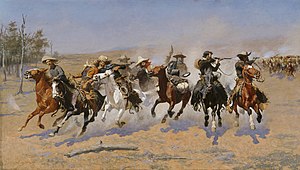
Back الحروب الأباتشية Arabic آپاچی ساواشلاری AZB Apačské války Czech Guerras apaches Spanish Apassisodat Finnish Guerres apaches French Perang Apache ID Guerre apache Italian アパッチ戦争 Japanese 아파치 전쟁 Korean
| Apache Wars | |||||||
|---|---|---|---|---|---|---|---|
| Part of the American Indian Wars | |||||||
 A Dash for the Timber, 1889, by Frederic Remington | |||||||
| |||||||
| Belligerents | |||||||
|
(1861–1865) |
Apache allies: | ||||||
| Commanders and leaders | |||||||
|
|
Flechas Rayada Chacon Black Knife † Mangas Coloradas † Iron Shirt † Cochise Francisco Juh Delshay Victorio † Nanni Chaddi † Na tio tish † Geronimo Chatto Apache Kid Massai Little Wolf (Mescalero) Te-He-Nan † Nana # Saguaro Coronado † Santos Red Dog | ||||||
The Apache Wars were a series of armed conflicts between the United States Army and various Apache tribal confederations fought in the southwest between 1849 and 1886, though minor hostilities continued until as late as 1924. After the Mexican–American War in 1846, the United States annexed conflicted territory from Mexico which was the home of both settlers and Apache tribes. Conflicts continued as American settlers came into traditional Apache lands to raise livestock and crops and to mine minerals.[1]
The U.S. Army established forts to fight Apache tribal war parties and force Apaches to move to designated Indian reservations created by the U.S. in accordance with the Indian Removal Act. Some reservations were not on the traditional areas occupied by the Apache. In 1886, the U.S. Army put over 5,000 soldiers in the field to fight, which resulted in the surrender of Geronimo and 30 of his followers.[2] This is generally considered the end of the Apache Wars, although conflicts continued between citizens and Apaches. The Confederate Army briefly participated in the wars during the early 1860s in Texas, before being diverted to action in the American Civil War in New Mexico and Arizona.